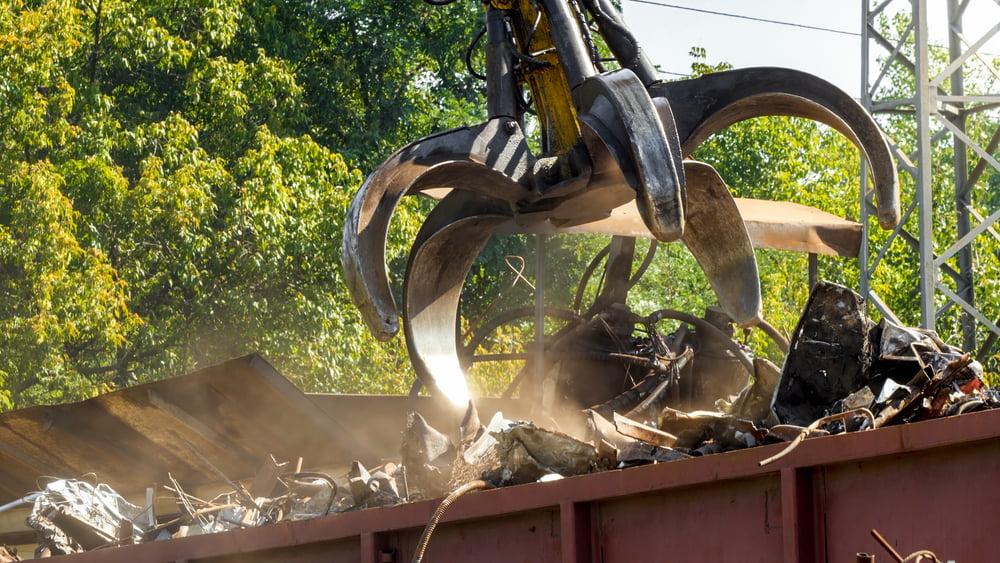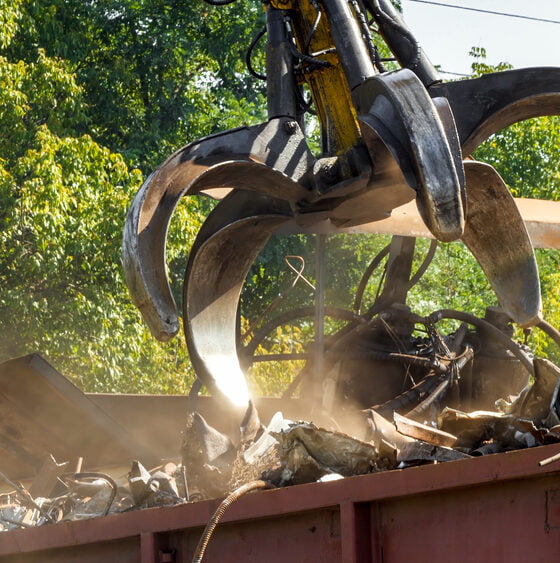Metal recycling is a process that starts with a consumer using a metal product and ends with another consumer using a new product made from the same metal. In between, recycling facilities recycle the metal so manufacturers can reuse it.
Recycling metal is important because it conserves natural resources, saves energy, and reduces pollution.
If you’re looking to get rid of any accumulated scrap metal, don’t just throw it in the trash. Instead, take it to a trusted recycling facility.
Before you do, though, we recommend taking a few moments to separate the metals by ferrous and nonferrous types. You can use a magnet to help with this process – simply wave it over your scrap pile. Ferrous metals will stick to the magnet because they contain iron.
Keep reading to learn our 7 steps to metal recycling:
1. Collection:
Designating collection bins in your garage or facility is the first step to start collecting scrap metal. Be sure to use bins that are sturdy and can hold the weight of the metal safely.
The collection process starts with you. You can find scrap metal at your business or home.
Designate bins in your garage or facility specifically for collecting scrap metal. Make sure the bins you use can safely hold the metal.
If your business generates a lot of scrap metal, some recycling facilities may help you arrange transportation.
2. Sorting:
Once the facility receives your scrap metal, they’ll begin the sorting process. Although you may have sorted the collection beforehand, the facility will do it again for quality assurance. First, metals are separated from other materials. Plastic is stripped from wires and metal pieces are removed from items. Then, the metals are sorted by type. This is done by looking at the color and weight of the metals.
The next step in the process is scrap metal processing. In this stage, the metals are first compacted and squeezed together to take up less space. Then, they are cut into smaller pieces using hydraulic machinery.
Hydraulic machinery can produce enough pressure to cut large pieces of metal by using a fluid that flows through motors and throughout the machine to pressurize it.
3. Processing
This brings us to our next step, scrap metal processing. During this process, the metals are first compacted and squeezed together to take up less space. Then, they are cut into smaller pieces with hydraulic machinery.
The next step in the process is scrap metal processing. In this stage, the metals are first compacted and squeezed together to take up less space. Then, they are cut into smaller pieces using hydraulic machinery.
Hydraulic machinery can produce enough pressure to cut large pieces of metal by using a fluid that flows through motors and throughout the machine to pressurize it.
4. Melting
With a large furnace, the metal is now melted. The furnace is set for each particular metal because each requires different levels of heat. This is because different metals are made out of different properties.
After the metal is melted in the furnace, it needs to be cooled. The size of the metal and the furnace will impact how long it will take to melt. It can be anywhere from minutes to hours. While this process does use energy, it is much less than what is needed to mine new metals.
5. Purification
When metals are purified from contaminants, this is known as electrolysis. In this process, an electric current is passed through the metal and the pure metal is deposited at the cathode, while impure metals are dissolved.
6. Solidifying
This is the finishing touches the metal goes through before it’s ready to be shipped out. First, chemicals are added to the melted metal to create the desired properties. The melted metals are then sent through a conveyor belt to a cooling chamber where they will solidify.
7. Transportation:
Now that the metals are purified and solidified, it is time to send them out to manufacturing facilities. The solid metals are packaged and transported on trucks. Then, manufacturers are able to make brand new products out of these metals. Finally, the products are sold to consumers and then the process starts all over again.
We all need to do our part to increase recycling rates for scrap metal. It’s good for the environment and helps our economy. You can start by taking your scrap to GLE Scrap Metal. They will purchase, process, and re-integrate all recyclable metals using environmentally-friendly processes.
Call GLE Scrap Metal today at 855-SCRAP-88.


 Environment10 months ago
Environment10 months agoAre Polymer Banknotes: an Eco-Friendly Trend or a Groundswell?

 Environment11 months ago
Environment11 months agoEco-Friendly Home Improvements: Top 7 Upgrades for 2025

 Features9 months ago
Features9 months agoEco-Friendly Cryptocurrencies: Sustainable Investment Choices

 Features10 months ago
Features10 months agoEco-Friendly Crypto Traders Must Find the Right Exchange



















